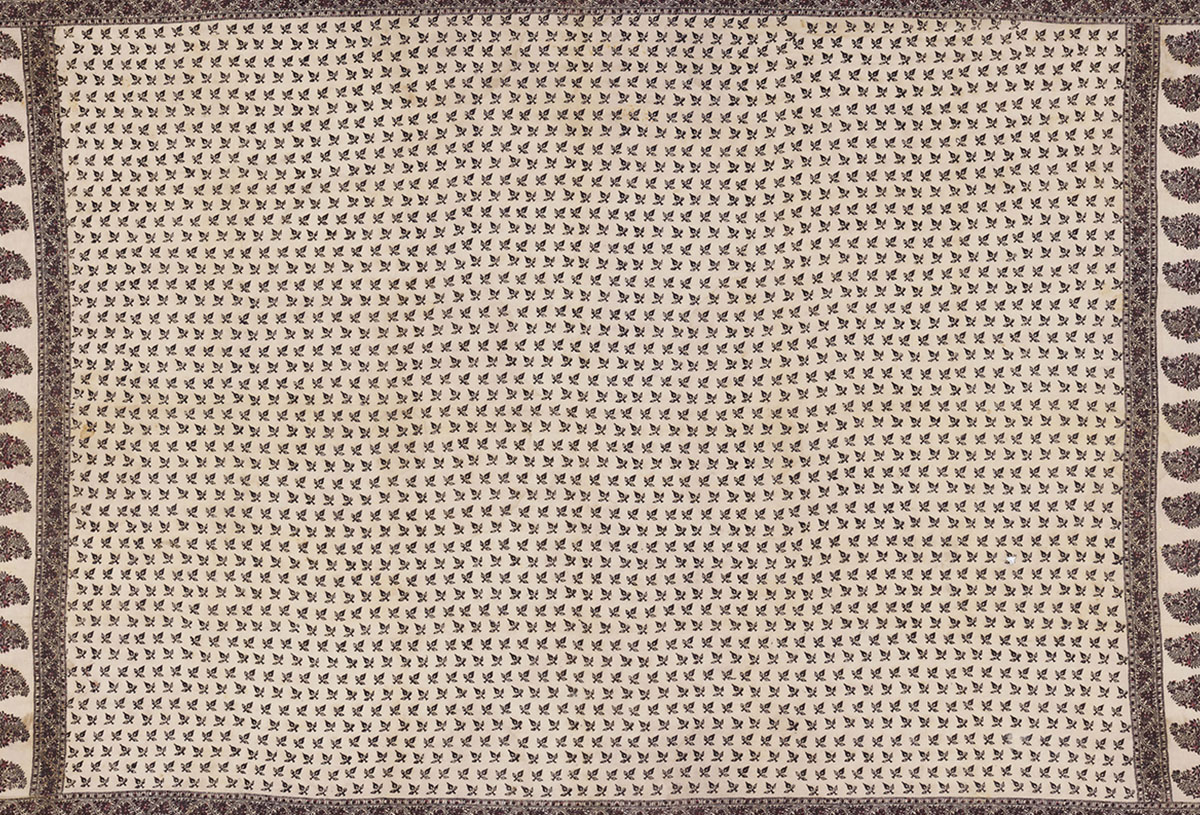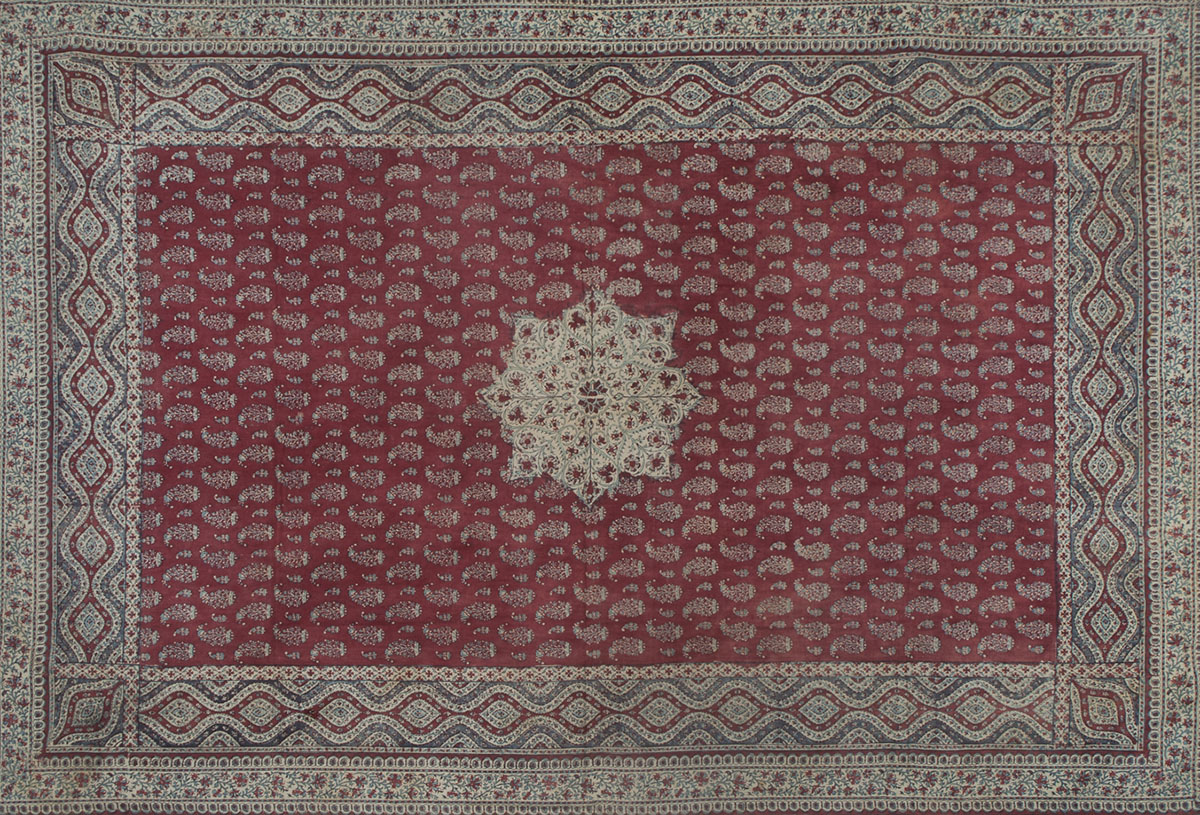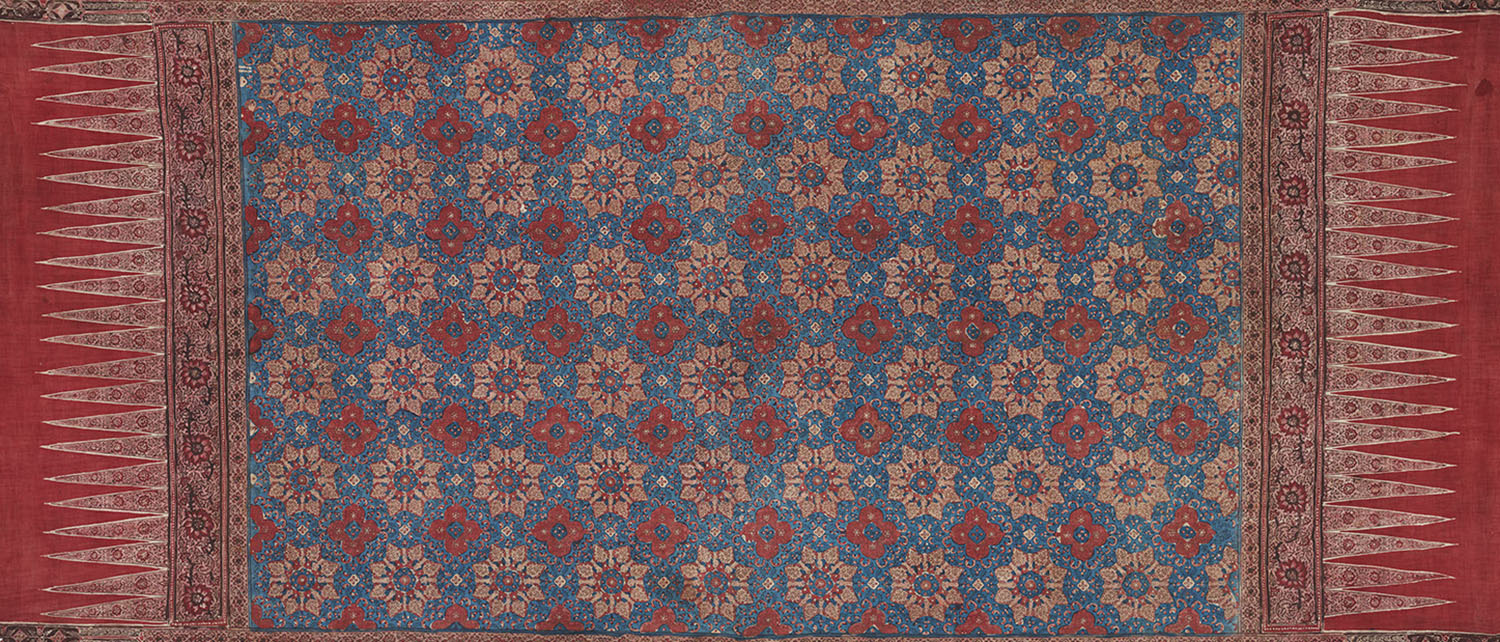ARTICLE
Block Printing
The process of stamping designs and patterns on base fabrics such as cotton or silk using dye-soaked, hand-carved wooden blocks. The technique is central to a variety of printing traditions across India in which blocks are used to create a range of designs composed of floral and religious motifs, geometric forms, and calligraphy. Some of these block printing traditions include ajrakh, Bagh, Bagru, Sanganeri, saudagiri, mata ni pachedi, namavali, and balotra, as well as the less popular traditions of the Chhimba community in Punjab and the more recent printing practices in Serampore of West Bengal. While several Indian communities practise the craft, the Khatris and Chippas in the country’s northwestern regions are the oldest known communities to have been continuously involved in block printing, since at least the sixteenth century.
Although, block printing is believed to have been practised in a rudimentary form as early as the Indus Valley civilization between 3000 BCE and 1200 BCE, direct textual evidence dates the craft of block printing on textiles to the eleventh century in Kerala. The earliest material evidence of these textiles and their international trade came from fragments of cloth from Gujarat found in Egypt and Indonesia dating back to a period between the thirteenth and fourteenth centuries. It has been inferred that these textiles were printed and dyed in blue and red during that time — and some were hand-painted using the technique of kalamkari.
Block-printed fabrics had experienced sustained international trade in the western and eastern regions of the Indian Ocean, before the establishment of first Europe-mediated and then European trade between the fifteenth and nineteenth centuries. The initially indirect trade was routed through the existing Indian Ocean and Southeast Asian markets by commercial officers from Portugal and the Dutch East India Company and French East India Company. The cultivation of a robust European market for Indian printed cloth such as Kalamkari and chintz, proved lucrative by British East India Company, which began to establish trade monopolies from the seventeenth century on.
The visual appearance of any block printed textile depends on the quality of the carving on the block, the richness of the dye and the effectiveness of the mordant used with it. While engraved blocks of metal and terracotta are sometimes used, those made from types of wood such as sheesham, sagwan and rohida are often preferred for their texture and ease of carving. Woodblock carving has been traditionally carried out in Gujarat and Rajasthan, each with producing blocks in distinctive styles. While in Gujarat, Pethapur has been the centre of block making, in Rajasthan, it is Jaipur that serves as the primary centre, both serving printing and dyeing clusters in their respective states as well as in Madhya Pradesh. is the primary blocks from Jaipur are best known for their precise cuts, which allow for cleaner printing with a lower risk of smudging. Contemporary block makers still prefer to use hand tools such as chisels to carve the blocks, alongside some mechanised tools such as small drills. Teak is the preferred variety of wood for making blocks, as it remains undamaged even after frequent contact with water and other substances used in the printing process. Air passages known as pavansar are also often drilled into the blocks to prevent them from clinging to the fabric when lifted.
A single printed motif may require the use of multiple blocks. For instance, one block can be used to create a rekh of the motif, another can be used to fill it, such as a datta, and a third block, such as gadh, can be used to create the background of the design. This requires both the block maker and printer to be aware of how every block will be used, and how the motifs will fit into the design. karigars also mark the date on each block, in case it needs to be repaired or altered, so that patterns will repeat perfectly when the fabric is printed.
Prior to printing, a mordant is typically added to the dye to allow it to stick to the base fabric because many natural dyes do not easily adhere to the cloth. Only a few — such as indigo, which is used in several block printing traditions and was a key product in colonial extraction — do not require the use of mordants. Although natural dyeing and printing was a thriving practice in India until the nineteenth century, karigars eventually began relying almost entirely on inexpensive chemical dyes. The use of such dyes has allowed two types of manual printing techniques to emerge: direct printing and discharge printing.
In addition to block printing, karigars also sometimes employ resist-dyeing, which includes techniques such as dabu printing and batik. Block printing, indigo dyeing and resist dyeing are often combined to produce complex, layered and multi-coloured patterns in traditions such as the aforementioned ajrakh, Bagru and Bagh.
The block printing technique in each region of the country is distinct, localised in terms of the materials and tools used as well as the cultural influences and social characteristics of particular communities. Traditionally, the raw fabric, motifs, colours and intricacy of block printed garments have served as designators of the wearer’s identity, caste, community, status and occupation. However, with the onset of urbanisation and market-driven mass production, these textiles have been redefined and adapted for contemporary consumption and usage, losing much of their social and symbolic values.
Block printing has had a long tradition in Asia, and particularly India, which though having undergone much change to meet varying market demands and technological and lifestyle changes, has mostly remained authentic and uncompromising in aesthetic and technique. Block printed fabrics have in recent years experienced an upsurge in Indian and international markets, leading to more concerted efforts towards the conservation and revitalisation of indigenous block printing traditions. One f the largest repositories of Examples of printed textiles and garments have constituted the collections of museums in India — such as Sanskriti Museum of Indian Textiles, Calico Museum, and the Anokhi Museum of Hand Printing.
Bibliography
Our website is currently undergoing maintenance and re-design, due to which we have had to take down some of our bibliographies. While these will be re-published shortly, you can request references for specific articles by writing to hellomapacademy@map-india.org.









